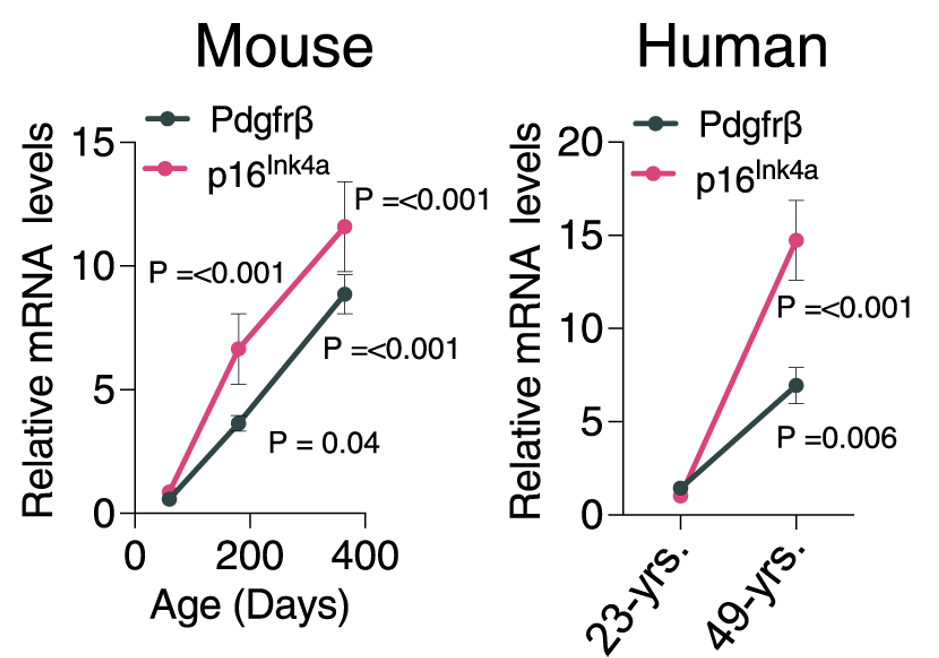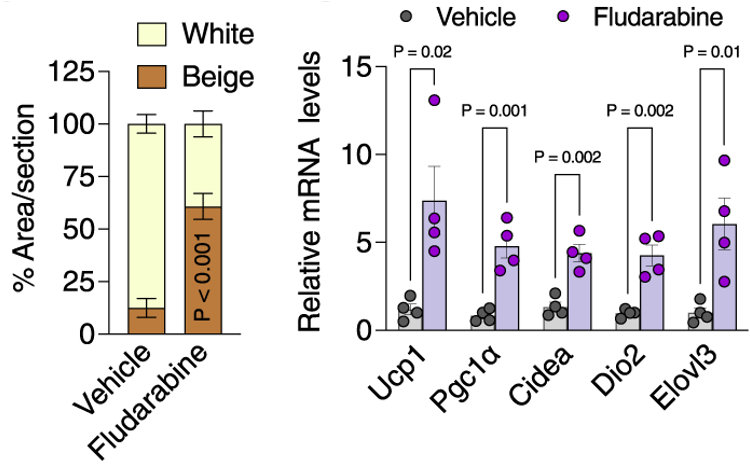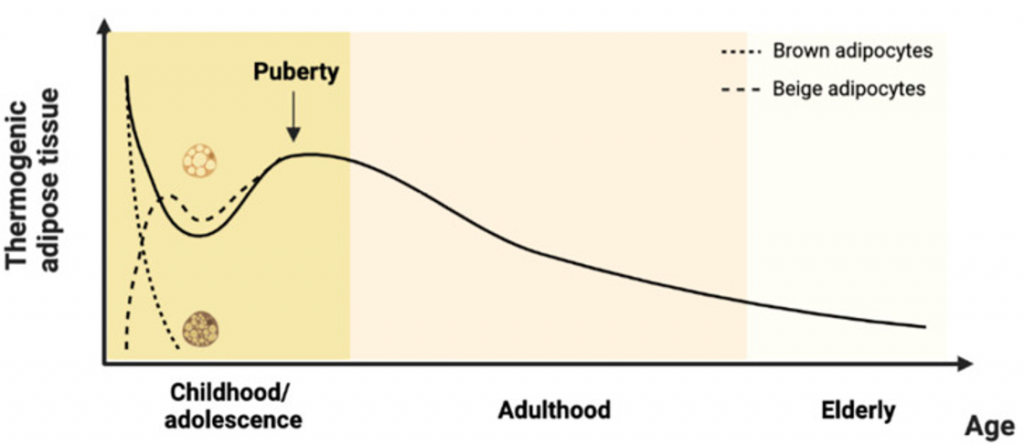Key Points:
- Both human and mouse stem cells show an age-dependent increase in a gene called Pdgfrβ, which regulates beige fat development.
- Blocking Pdgfrβ signaling with fludarabine increases beige fat development in middle-aged mice upon cold exposure.
- Imatinib, which inhibits Pdgfrβ directly, also increases beige fat in middle-aged mice exposed to cold.
In response to cold, our fat stem cells have the remarkable capability of developing into beige fat cells. Once generated, beige fat cells burn the sugar and fats circulating in our bloodstream to produce heat instead of energy. However, our stem cells decline with age, and the beiging process begins to fail as early as the age of 35. Since beige fat cells could counter obesity, the authors of a new study published in Nature Communications state the following:
“The inability to generate cold-induced beige fat in aging humans has created a clinical obstacle to their therapeutic promise. Thus, finding ways to restore beige adipocyte development in adult humans has clinical utility.”
The authors, Benvie and colleagues from Cornell University, have now found that a protein called Pdgfrβ drives age-related fat tissue stem cell dysfunction. Furthermore, by targeting Pdgfrβ signaling with fludarabine or imatinib, they restore beige fat cell development in middle-aged mice. These findings suggest that such drugs could be used in older adults to rejuvenate beige fat cell development to counter obesity.
Anti-Cancer Drugs Counter Age-Related Beige Fat Tissue Decline
Pdgfrβ has been linked to regulating fat tissue development and homeostasis, but its role in beige fat development and aging is unclear. To explore this, Benvie and colleagues analyzed age-dependent changes in fat stem cell (adipocyte progenitor cell) genes. They found differences in 3,400 genes, including an age-related increase in the Pdgfrβ gene. Fat tissue donated by young (~23.5 years) and middle-aged (~49.33 years) individuals also showed an age-dependent increase in the Pdgfrβ gene.
In addition to the Pdgfrβ gene, both mouse and human fat tissue showed an age-dependent increase, and the p16Ink4a gene, a marker for age-promoting senescent cells, which are thought to drive aging. While fat stem cells appear to become senescent with age, further experiments showed that such senescence does not seem to interfere with beige fat cell development. The authors state:
“Our current study supports the notion that beige [fat stem cells] appear to be senescent but suggest other age-dependent mechanisms can interfere with the beiging process.”

In elucidating Pdgfrβ’s involvement in beige fat cell development, Benvie and colleagues found that Pdgfrβ activates a protein called Stat1, which modulates immune cell responses. To investigate the effect of blocking Stat1, the researchers injected middle-aged mice (12 months) with 3 mg/kg of fludarabine, a Stat1 inhibitor that is FDA-approved to treat leukemia and lymphoma.
Following five days of fludarabine treatment, the mice were housed in cold (6.5 °C) for seven days. Upon cold exposure, fludarabine was shown to restore beige fat development and increase the activation of genes involved in thermogenesis — when mitochondria produce heat instead of energy. These findings suggest that beige fat cell development can be rejuvenated with at least one existing drug.

To test if directly blocking Pdgfrβ restores beige fat generation, middle-aged mice were injected with either 5 mg/kg of imatinib, FDA-approved to treat leukemia, or SU16f, which also blocks Pdgfrβ. Following cold exposure, both drugs led to an increase in beige fat development and thermogenic gene activation. The same did not occur in young (2 months) mice, suggesting that restoring beige fat development with imatinib is age-dependent.

Can Beige Fat Cells Be Revived without Cold?
Beige fat should not be confused with white fat, which is composed of fat cells that store excess energy, thus making us larger if we consistently consume excess calories. Beige fat is also not brown fat, which is similar to beige fat but declines rapidly as we grow out of infancy. Beige fat, like brown fat, is thermogenic but does not begin to decline until puberty.

Thermogenic fat cell decline has been attributed to fat stem cell dysfunction, hormonal changes, inflammation, and dysfunctional mitochondria, among other pathologies. Restoring age-related thermogenic fat loss could improve insulin resistance, type 2 diabetes, nonalcoholic fatter liver disease, cardiovascular disease, and increase longevity. So, can beige fat cells be rejuvenated without cold?
There is not enough evidence to definitively propose that any one intervention can rejuvenate beige fat development. However, a pilot study of older individuals with kidney disease showed that dasatinib and quercetin (D/Q) reduced senescent cells in fat tissue. D/Q are senolytics — compounds that eliminate senescent cells. While beige fat was not measured in this pilot study, it’s possible that senolytics like D/Q could rejuvenate healthy fat stem cells by eliminating senescent fat stem cells, allowing for the development of beige fat in old age.